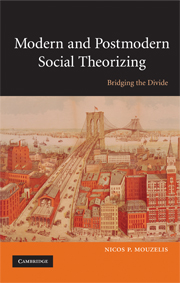Book contents
- Frontmatter
- Contents
- List of figures
- Acknowledgements
- Introduction
- Part I The theoretical background: the development of the agency–structure problematic
- Part II Parsonian and post-Parsonian developments
- Part III Agency and structure: reworking some basic conceptual tools
- Part IV Bridges between modern and late/postmodern theorizing
- Part V Towards a non-essentialist holism
- 13 Grand narratives: contextless and context-sensitive theories
- 14 The actor–structure dimension: anti-conflationist holism
- 15 The micro–macro dimension: anti-essentialist holism
- 16 The inter-institutional dimension: beyond economism and culturalism
- Instead of Conclusion: Twelve rules for the construction of an open-ended holistic paradigm
- Appendix: In defence of ‘grand’ historical sociology
- References
- Index
16 - The inter-institutional dimension: beyond economism and culturalism
Published online by Cambridge University Press: 05 June 2012
- Frontmatter
- Contents
- List of figures
- Acknowledgements
- Introduction
- Part I The theoretical background: the development of the agency–structure problematic
- Part II Parsonian and post-Parsonian developments
- Part III Agency and structure: reworking some basic conceptual tools
- Part IV Bridges between modern and late/postmodern theorizing
- Part V Towards a non-essentialist holism
- 13 Grand narratives: contextless and context-sensitive theories
- 14 The actor–structure dimension: anti-conflationist holism
- 15 The micro–macro dimension: anti-essentialist holism
- 16 The inter-institutional dimension: beyond economism and culturalism
- Instead of Conclusion: Twelve rules for the construction of an open-ended holistic paradigm
- Appendix: In defence of ‘grand’ historical sociology
- References
- Index
Summary
Having discussed the type of action–structure and micro–macro linkages that are presupposed in a non-essentialist, open-ended, holistic conceptual framework in the two previous chapters, it remains to examine what presuppositions are necessary for examining the linkages between institutional spheres (economic, political, social and cultural) in a way that avoids aprioristic, not empirically founded positions about the dominance of one sphere over the others.
Economism
As pointed out in previous chapters, the strongest argument that can be made for Marx's holistic framework is that it avoids the conflation of objectivist and subjectivist approaches seen in Giddens' and Bourdieu's writings; it also avoids the imbalance between systemic and action approaches seen in Parsonian and Althusserian functionalism at one extreme, and in interpretative micro-sociological approaches at the other. Viewed as a whole, Marx's work achieves a remarkable balance and successfully combines systemic-institutional and actor-oriented perspectives. It views social development in terms of both systemic contradictions of institutional parts (system integration/disintegration) and actors' struggles (social integration/disintegration). It is important to repeat once more that Marx not only accepts methodological dualism (i.e. the necessity, in Habermas' terms, of both an internalist and an externalist perspective), but changes from one to the other without any conceptual acrobatics – since the key concept of technology (the forces of production) plays a crucial role in moving in a theoretically coherent manner from systemic contradictions to actors' struggles.
- Type
- Chapter
- Information
- Modern and Postmodern Social TheorizingBridging the Divide, pp. 261 - 273Publisher: Cambridge University PressPrint publication year: 2008

